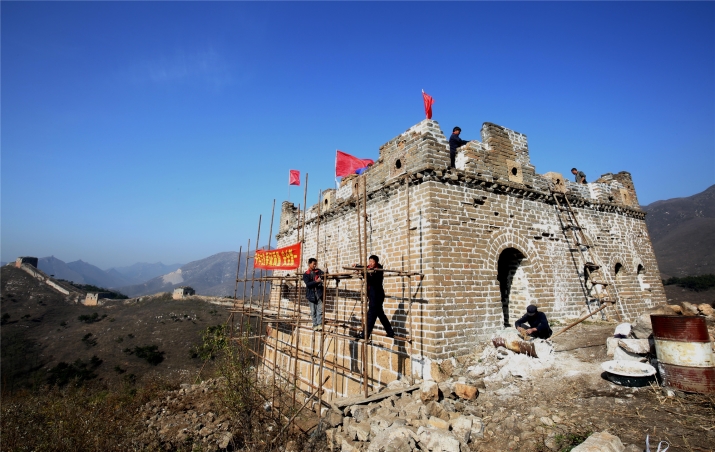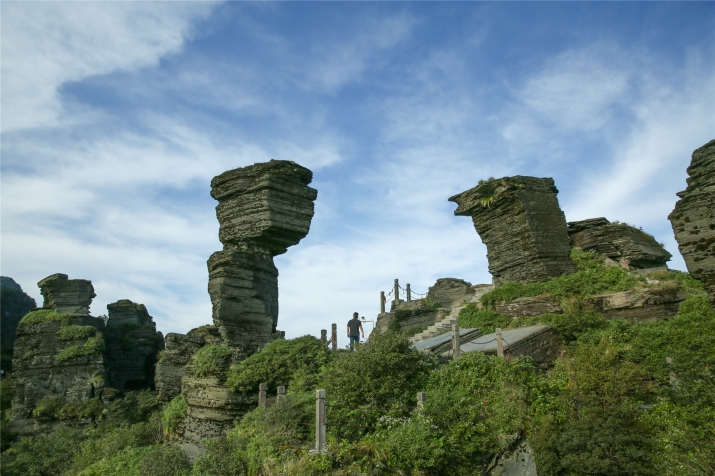|
||||||||||
| Home Nation World Business Opinion Lifestyle ChinAfrica Multimedia Columnists Documents Special Reports |
|
||||||||||
| Home Nation World Business Opinion Lifestyle ChinAfrica Multimedia Columnists Documents Special Reports |
| ChinAfrica |
| In Need of Protection |
| As its UNESCO World Heritage list grows, China seeks innovative ways to protect its assets |
| By Liu Ting | VOL.10 August 2018 ·2018-08-20 |

After a long wait, the news he had been waiting for so impatiently was finally released: Fanjing Mountain, where he now lives, became China's latest addition to the UNESCO World Natural Heritage List.
"It's really worth it," said He.
He first set foot on Fanjing Mountain, in southwest China's Guizhou Province, in 2006. As a photographer with an eye for landscapes, he was immediately fascinated by the beauty of the place. So much, in fact, that he decided to sell his house in Guangzhou and settle on the mountain. Since then, he has undertaken the task of capturing Fanjing Mountain's wild beauty with his camera. Over the last 12 years, he says he took more than 100,000 photos of the mountain from all angles.
Comparing photos taken 12 years ago to others taken recently, he finds that almost nothing has changed: This means that the local government attaches much importance to protection of the mountain.
"But now that Fanjing Mountain has been placed on the UNESCO World Natural Heritage List, we will need to put even more emphasis on its protection," he said.
Technology to the rescue
China signed the Convention Concerning the Protection of the World Cultural and Natural Heritage on November 22, 1985, and became a member of the World Heritage Committee on October 29, 1999. Since then, the country has taken an active role in protecting its World Heritage sites. Including Fanjing Mountain, the country now has 53 UNESCO-recognized sites, ranking it the second in terms of the number of the World Heritage sites after Italy.
In recent years, China added another string to its bow by using modern technology to better protect its heritage sites. On April 25, American tech giant Intel and the China Foundation for Cultural Heritage Conservation signed a partnership agreement to protect and restore the Great Wall of China using drones and artificial intelligence (AI).
"As one of the Seven Wonders of the World, the Great Wall has been exposed to weather erosion for thousands of years. Some parts are located on steep slopes which makes daily maintenance a huge challenge. Our partnership with Intel opens up new opportunities for preservation," said Li Xiaojie, President of the Foundation.
The Jiankou Section of the Great Wall is among the most famous and steepest. Located in a thick forest, the section of the wall, which dates back to the third century B.C., has been severely tested by time and weather. Intel's Falcon 8+ drones will be used to map the area through aerial photography, generating high-definition 3D images that will allow teams to assess the current state of damage. The data will then be processed by AI, which will create 3D modelling of the Great Wall to effectively and safely identify areas in need of repair. All this would have been impossible without new technologies.
Beyond the Great Wall, other important heritage sites have also benefited from modern technology. The Mogao Caves, located in a deserted area of Dunhuang in northwest China's Gansu Province, have been listed as a UNESCO World Cultural Heritage site since 1987. While the site was under the threat of natural erosion and human impact, local authorities decided to launch a large-scale digitization project of the caves in the 1990s.
After more than 20 years of work, a hundred caves underwent digitization and 3D modeling. Since April 29, 2016, the Mogao Caves can be visited through high-definition virtual reality on the Internet.
"With these tools, we wish to open up these treasures of humanity to a greater number of visitors and help promote studies and research on Mogao Caves in China and beyond," said Wang Xudong, President of Dunhuang Academy, the unit responsible for protecting and studying the caves.

Fanjing Mountain in Guizhou Province (YAO LEI)
Tourist management
The status of being a UNESCO World Heritage site can also help develop tourism. Pingyao Ancient City in north China's Shanxi Province became a World Heritage site in 1997. Soon after, the number of visitors soared from 50,000 in 1997 to more than 1.5 million in 2016. It was the same for the Longmen Caves in Luoyang of central China's Henan Province, listed in 2000: Ticket sales increased from 10 million yuan ($1.49 million) in 2000 to 27 million yuan ($4.03 million) in 2001.
But overdevelopment in tourism of some World Heritage sites brought problems in protection.
"I once helped to protect the ancient cities of Pingyao and Lijiang (in southwest China's Yunnan Province), but after they became popular tourist sites, things took a rather ugly turn," said Ruan Yisan, Professor at Shanghai Tongji University.
The situation is so severe that the ramparts of Pingyao Ancient City have collapsed three times in two years because of the excessive number of tourists. In Dunhuang, caves have become victims of their popularity, which has accelerated oxidative damage to the frescoes.
"The main value of World Cultural Heritage sites lies in their cultural function, not their economic function. In some places, these sites are considered first as tourist attractions and are overexploited, which is wrong," said Xie Ninggao, Professor at the World Heritage Research Center of Peking University.
In fact, as early as 2002, the State Administration of Cultural Heritage, then Ministry of Culture, and other related governmental bodies jointly issued a regulation stipulating that the protection of World Heritage sites should be a prerequisite for their exploitation. In fact, the Chinese Government has stepped up its monitoring of management programs in its World Heritage sites and rejected those deemed unreasonable.
"Protecting and exploiting World Heritage sites are not contradictory goals, and local authorities must adopt effective methods to achieve win-win results," said Zhao Yun, Researcher with the Chinese Academy of Cultural Heritage.
(Comments to liuting@chinafrica.cn)
| About Us | Contact Us | Advertise with Us | Subscribe |
| Copyright Beijing Review All rights reserved 京ICP备08005356号-5 京公网安备110102005860号 |